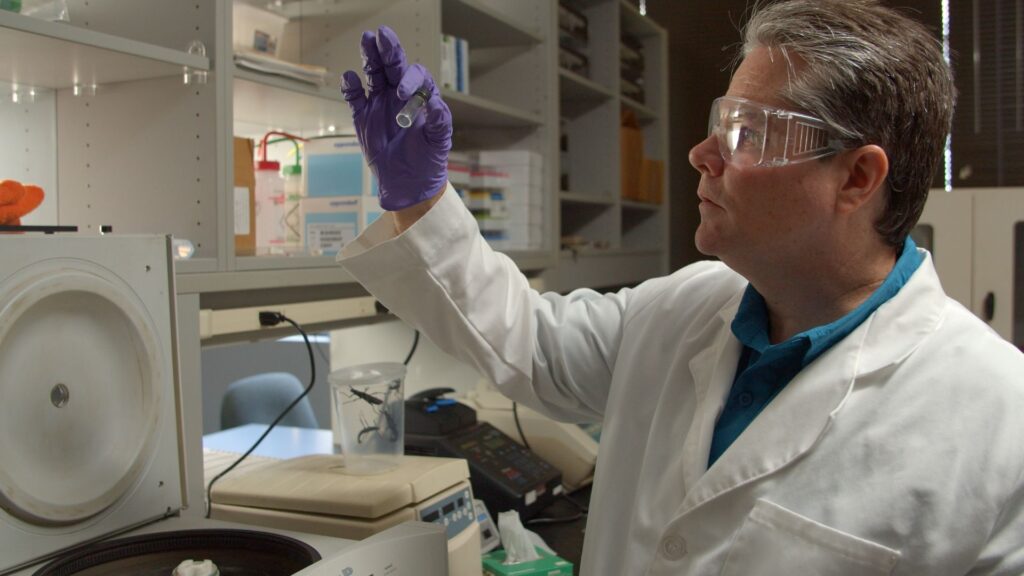Environmentalists have pushed insect foods as a lower-emission alternative to red meat, and nutritionists have been promoting insect-based foods as a source of protein.
It’s not an easy sell in the Western world.
People regularly eat crickets in Thailand, scorpions in China, mopane worms in Zimbabwe and ants in Brazil. In the U.S., we’re happy to get honey from bees, wear silk from worms or put on lipstick containing dye from insects. But insects are generally not found on the menu.
All Things Bugs
Dr. Aaron Dossey has been struggling to promote insect foods and change consumer perceptions for more than a decade.
He set up All Things Bugs LLC, based in Oklahoma City, Oklahoma, in 2011 and landed some small grants to keep going. He said he’s had a fascination with insects most of his life.
“I had to do insect collections for honors biology and zoology in high school. I just always loved nature and fell in love with insects because they’re cool,” Dossey told Cowboy State Daily.
Besides selling patented cricket powder, the company has been researching genetic engineering, food processing and product development to make insect foods a viable and accepted part of the American diet.
It hasn’t gone quite as well as he hoped.
“I’m running out of money, but we’ll see how this summer goes,” Dossey said.


Hopper Dozers
Scott Schell, University of Wyoming extension entomology specialist, said he’s not aware of any insect farms in the Cowboy State.
During the state’s periodic large grasshopper infestations, Schell said he’s received inquiries from people trying to figure out how to harvest the insects as animal feed.
“Yes, it’s possible, but it’s not very practical because you can’t rely on them being abundant every year,” Schell said.
During the first half of the 20th century, before widespread use of pesticides, there would be big outbreaks of Rocky Mountain locusts. With crops getting decimated by the insects, farmers would use hopper dozers, as they called them, to clear the insects out of the field.
Most often, they just wanted to kill them, but if times got tough enough, starving farmers were more open to feasting on the bugs killing their crops.
Protein Supplement
Trying to normalize the consumption of insect foods, Dossey is very particular about how his cricket powders are described. They are not flours, and he even spent quite a bit of money buying URLs that refer to cricket flour.
“Flours are exclusively for plants,” Dossey explained. “They’re high starch, low protein, and low oil.”
Cricket powders or other insect powders, however, are high in protein, and Dossey said if you try to prepare foods, such as breads and cookies, with powders like you would flour, they come out wrong.
“You can use it in baked goods, but it’s like a protein supplement,” Dossey said.
For example, if you wanted to bake a cricket-powder cookie, it could be done. However, you’d replace about 15% to 20% of the flour with cricket powder.
The powder also has a stronger flavor than typical flour, he said. So, that 20% mix works well in a chocolate or cinnamon cookie. In a plain white sugar cookie, Dossey recommends mixtures around 10%.
All Things Bugs has developed a number of products from its powders, including cereals, pastas, tortillas, bars, shakes, smoothies and puffed snacks — cricket Cheetos.

Chirping Farms
Crickets are the most common commercial food-grade insects raised in the U.S., so that’s where All Things Bugs started with its product line.
Dossey sources his crickets from Armstrong Cricket Farms in Louisiana.
The crickets are raised indoors in warehouses with concrete floors. The crickets themselves are grown in tubs with different materials for the insects to crawl on. Dossey said the farms are noisy, as you’d expect.
“There’s chirping. It’s not overwhelming, like a factory or something. But yeah, there’s a lot of chirping,” Dossey said.
He had some research funding into cricket farming, trying to figure out the most efficient use of space, as well as ways to use reusable crawling materials to cut down on waste.
Dossey said there’s potential for other types of bugs to be food sources. There now are no food-grade mealworm farms. That’s are another high-protein insect that can be made into a powder.
“I think they could potentially be produced more efficiently and much cheaper than crickets,” Dossey said.
Breakfast Of Champions
Dossey said that besides the need to change public perception about eating insects, pairing up with large food producers is another challenge.
He said he’s reached out to major food producers, and a couple big-name companies bought 100 pounds of cricket powder. He said the main barriers are economical.
“It all comes down to money and profitability. If the price is too high for the gradients, they won’t use it,” Dossey said.
If he develops a partnership with one of the large corporations, getting past the consumer aversion to eating bugs wouldn’t be a problem, he said.
“You just get an athlete to go on TV and eat it, and then everybody will want it,” Dossey said.
Besides the nutritional and environmental value to insect foods, Dossey said, they create food security. If there are major disruptions in the livestock industry, insects would still be available to keep people from starving.
“There’s no data suggesting these foods are dangerous or unsafe,” Dossey said.





